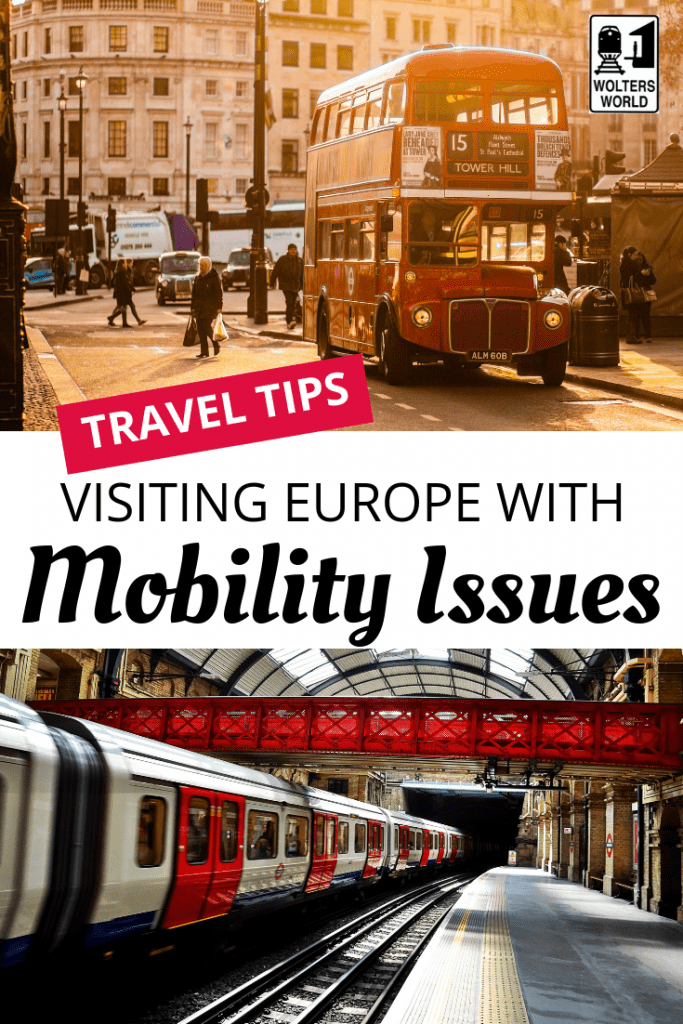Hey there, fellow travelers! We’re in Lisbon, Portugal and today we’re talking about handicapped travel in Europe. Whether you use a wheelchair to get around or have limited mobility going up and down stairs, there are extra things to consider when planning a trip to Europe. This post is a direct response to reader questions and comments from our fans looking for advice. There is no ADA in Europe, and some of the cities and buildings are incredibly old so they haven’t been retrofitted to accommodate mobility issues. Even cobblestone streets can prevent a challenge, so that’s why we’ve created this list of 10 things to think about when planning a trip to Europe with mobility issues.
#1 Ask If Your Hotel is Handicap Accessible
European hotels are not made for accessible travel needs. Many of them involve steep, narrow staircases. If they do have an elevator, it is often very small. Sometimes, it’s even difficult to get into the front door of the lobby as everything seems to have steps up or steps down. You may have to pay a premium to stay in a more modern hotel that is able to accommodate your needs. Also, consider the location of your hotel as getting around cities isn’t always easy, so you are better off to spend a bit more for a convenient location, rather than trying to commute by train to the city center each day.
#2 Research Public Transportation
The accessible modifications on public transportation vary widely by transportation type and by city. Buses seem to be very reliable and most of them have lifts now that can transport a wheelchair on and off the bus. On the metro systems, though, not all stations have an elevator and you might even find elevators not working in the stations that are supposed to be accessible. If you plan on using the Metro during your trip, you will need to carefully map out which stations are accessible against the locations you want to visit.
Read: Five Things You’ll Love & Hate About European Train Travel

#3 Cobblestones Everywhere
Many of the streets and sidewalks in Europe are still paved in cobblestones, which are uneven after a couple of centuries. This is difficult enough, but then consider that a lot of places don’t have curb ramps to help you transition from the sidewalk to the street. Just getting around can be difficult, which is why it pays to stay as close to your desired attractions as possible.
#4 European Attitudes
The European attitude toward travelers with mobility challenges is a challenge in itself. There are some old-fashioned attitudes who don’t think things should be changed for a small group of travelers. They definitely are not as accommodating as what you might be used to in the United States, especially with so many regulations and requirements. Europeans are often more reserved than Americans, so they won’t show much empathy or go out of their way to point you in the right direction unless asked directly.
#5 Research Tourist Sites
Traveling with a disability is going to require a bit more research, even down to how you choose which cities and sites to visit. The European Union has come up with “Access City Awards” to recognize cities that are helping to create a barrier-free Europe. If you aren’t sure where to go in Europe, this list is a great one to start with, as they have been awarded for their efforts in accessibility. Likewise, not all tourist sites are equal, so make sure you know ahead of time which ones are accessible. You can sometimes hire a private guide for wheelchair accessible tours in Europe, or sign up for disabled access tours with a group.

Watch: Top Ten Cities in Europe for Disabled Travelers
#6 Restaurant Space
Many restaurants in Europe are very small, so you’ll find the tables are packed in close to each other. Even a large guy like myself has a hard time getting around in restaurants. There’s an easy fix to this one, though: visit during warmer months when the sidewalk cafes are set up. Then you don’t even have to enter the restaurant and can sit in a more spacious sitting area.
#7 Toilets
Toilets are another challenge when traveling throughout Europe. They might even have a totally accessible toilet stall, except the doors are too narrow. So, even though the bathroom may say handicap accessible, it helps to send a scout first to check it out and verify if it’s really accessible.
#8 Have a Plan B
It’s best to plan out your days as much as possible, but always have a Plan B. In the case of a broken elevator, what are your other options for that day?
#9 Have Fun!
Don’t let all of this scare you from visiting Europe! These examples are the worst-case scenario, and most likely you won’t run into any issues at all, but it’s just good to be prepared. Europe is amazing and you’ll love the experience!
I hope this helps answer some of the frequent questions we get around mobility-accessible travel in Europe. There are some really great resources out there, including Sage Traveling, who puts together amazing detailed guides with photos of challenges you can expect while traveling through Europe with a disability. Do you have tips on traveling through Europe with mobility issues? Tell us in the comments! In the meantime, check out these blog posts and videos for more travel tips:

